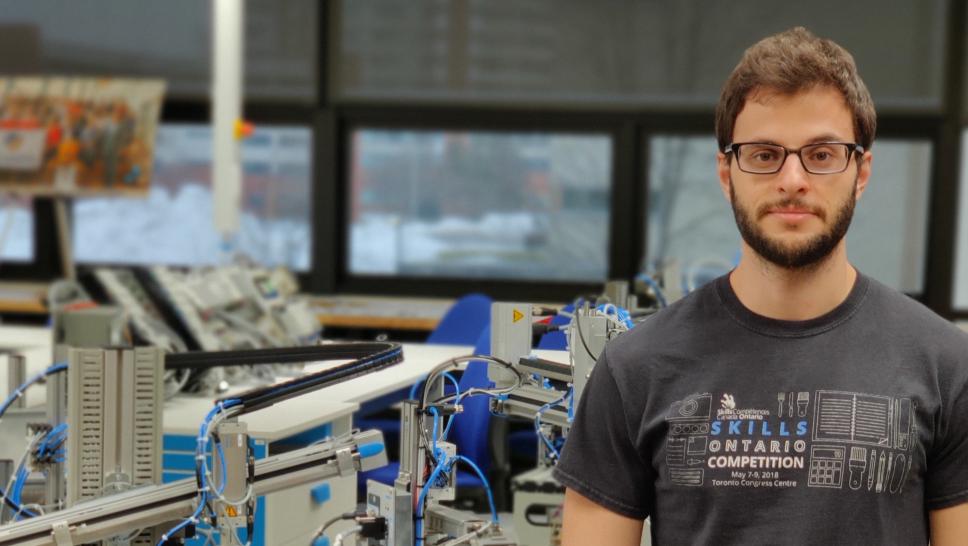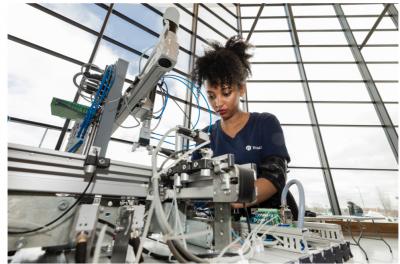
The first cohort of students in Humber College's new Bachelor of Engineering programs will start classes in September 2021, and not a moment too soon. As the industry grows, changes and adapts to Canadian society, more engineers are needed to build and maintain the infrastructure and technology we depend on.
Industry 4.0 brings a digital transformation that is changing the way we live and produce products and engineering graduates are needed to address a growing skills gap.
The degrees include: Bachelor of Engineering - Information Systems Engineering, Bachelor of Engineering - The Built Environment and Bachelor of Engineering – Mechatronics.
"The Faculty of Applied Sciences & Technology is renowned for offering more than 40 comprehensive programs in design, engineering and engineering technology, and skilled trades from our state-of-the-art facilities," says Farzad Rayegani, senior dean of the Faculty of Applied Sciences & Technology. "Built on our expertise in mechatronics, sustainability and information technology, Humber's new engineering degrees will blend classroom theory with project-based learning providing students with the critical-thinking and hands-on skills needed to prepare the next generation of engineering leaders."
Mauricio Toigo was thrilled to learn that Humber would be offering Engineering degrees. Toigo is a graduate of the Mechanical Engineering Technology diploma program and has been working at the college since he finished the program in 2019.
“My favourite part of the program was the access to labs. The investment that goes into the program is huge and makes a big difference,” said Toigo.
“Its a good place to learn.”
Now the alumnus has a full-time, permanent position as an advanced manufacturing technologist, maintaining and installing the same equipment he so enjoyed using as a student.
Toigo has always wanted to continue his education, but it was difficult to disconnect from the industry to go back to school.
“Working here and having Humber offer a degree program is huge for me,” he said.
Toigo's current credentials will count towards the degree through Humber’s diploma-to-degree pathways. He hopes to pathway into third year of the Bachelor of Engineering – Mechatronics program with the first cohort in 2024.
The Bachelor of Engineering – Mechatronics program will be co-delivered at Sault College in Sault Ste. Marie. The initiative will provide increased access to post-secondary education options for students in Northern Ontario.
Living lab sets Humber apart
"Engineering education is increasingly expected to provide more opportunities that foster and nurture systems-thinking and creativity in engineering students. More importantly, educators should demonstrate critical thinking, creativeness and innovativeness in their methodologies," says Rayegani.
"The methodology of the engineering programs at Humber College is based on the integration of project-based learning. This blended approach encourages students to develop their problem solving and critical systems-thinking skills through their involvement in real-life industrial projects. In addition, our Humber living labs and the Centres of Innovation play a critical role in our approach to foster the next generation of engineering leaders," he adds.
Humber’s Engineering degrees around the idea of campus as a living lab. Spaces like the Humber Arboretum and the Barret Centre for Technology Innovation a provide opportunities for learning that make Humber’s programs unique.
He describes Humber’s Arboretum as a living lab for the built environment, where a student has 250-hectares of learning space. The whole Humber database centre is a living lab for the Information System Engineering program.
“Humber’s new parking lot with solar panels will provide students in the Built Environment degree. With the opportunity to measure and analyze data, suggest design changes. We have a new parking lot at the North campus. There are solar panels incorporated, so all the students in Built Environment will go there and analyze its data,” said Rayegani. 
For the Mechatronics and Information Systems Engineering students, the Barrett Centre for Technology Innovation is a technology powerhouse and home to the latest in areas such as automation, robotics, systems integration, user experience testing, applied research and work-integrated learning.
Three degrees, endless possibilities
Engineering students can choose from three distinct programs that reflect the current industry climate.
The Built Environment program focuses on human-made elements, like buildings and cities, that contribute to the quality of our environment.
“You didn’t pay attention to human health when you were building a ten-storey building 20 years ago. Now, often a new development must have a porch and elements that improve quality of life,” said Rayegani.
“You think about how to build a bridge or a house or a community in a way that is sustainable.”
The Information Systems Engineering program prepares students to work with the exchange of data impacting software applications, security and high-tech devices.
The field is developing rapidly as devices and apps become more prominent and complex.
“The Internet of Things, where everyday products such as cars, homes and appliances are integrated with Wi-Fi and network connectivity, will rapidly change the way we live. For example, IoT will allow people to turn on their home appliances remotely, and make many activities around the home much easier,” said Dr. Rayegani. "For many organizations, the intelligent aspects of IoT devices that can operate like a digital personal assistant will help employees and companies work more efficiently." he adds.
Humber’s Bachelor of Engineering-Mechatronics brings together the disciplines of electrical, mechanical, electrotechnical engineering. The program will arm students to work with robotics, electronics, computers, system controls and artificial intelligence.
According to Rayegani, “The Manufacturing sector in Ontario is looking for engineering graduates who can help them to adopt new technology such as robotics and AI. Today, robots are not just used for repetitive work or to move items around a warehouse. Artificially intelligent robots, like drones, collaborative robots and self-driving cars are changing the way we live and work.”
These devices can be at the consumer level, like a cell phone or computer, to the highest level of industry or manufacturing, like robotics and automation.
Each degree is designed to meet the accreditation requirements of the Canadian Engineering Accreditation Board (CEAB). Humber will be eligible to apply for CEAB accreditation upon the graduation of the first cohort of students.